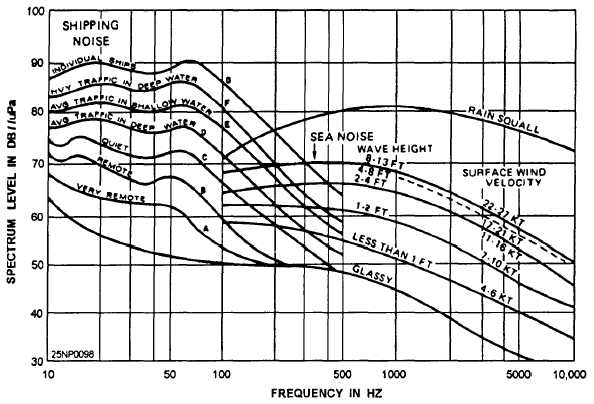Figure 9-13.-Ambient noise levels.
Four or more ships closer than 30 nmi constitute
heavy noise, with ships closer than 10 nmi
driving the noise level up to the individual ship’s
target curve (curve G). Where the bulk of the
traffic is farther than 40 nmi, the average traffic
curves (curves D and E) apply. This does not
apply to a carrier task group.
Correlations of noise intensity with distance to
nearest ship, with all ships present in the shipping
lanes, were negative. For areas not immediately
in a heavy traffic area, ship concentration and
distance became critical.
SURFACE-SHIP TRAFFIC NOISE
At the lower frequencies the dominant source of
ambient noise is the cumulative effect of ships that are
too far away to be heard individually. The spectrum of
the noise radiated from ships as observed at great
distances differs from the spectrum at close range due
to the effect of frequency-dependent attenuation.
Sea-state noise
Sea state is a critical factor in both active and passive
detection. Inactive sonobuoy detection, waves 6 feet or
greater will start to produce a sea-state-limited situation.
For shipboard sonar systems, location of the sonar
dome, ship’s speed, course, and relation to the sea all
have an effect. The limiting situation is generally sea
state 4 or 5. For passive detection, the noise level
created by wind waves of 10 feet or greater will result
in a minimum of antisubmarine warfare (ASW)
operational effectiveness, depending on the type of
sensor.
WIND-GENERATED NOISE.– Sea-state noise
generated by surface wave activity is usually the
primary component over a range of frequencies from
300 Hz to 5 kHz. It maybe considered to be one of the
most critical variables in active and passive detection.
SEA-STATE NOISE LEVELS.– T h e
wind-generated noise level decreases with increasing
acoustic frequency and increases with increasing sea
state (approximately 6 dB for each increase in sea state).
It is very important to understand that all sound-sensor
ranges are reduced by additional noise, and that there
can be a 20-dB spread in background noise between
various sea states.
9-12



